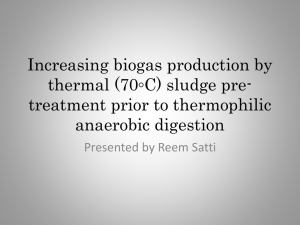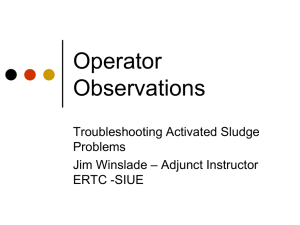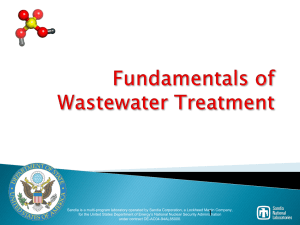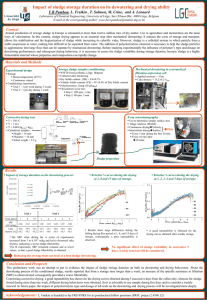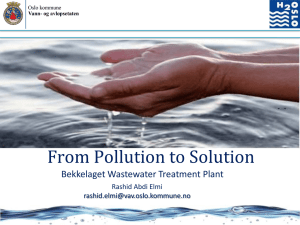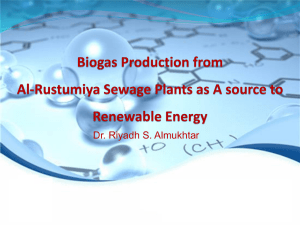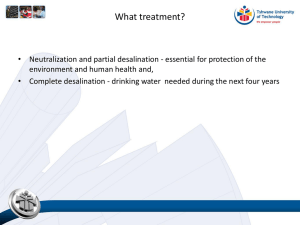ww16_sludge_2_slides
advertisement
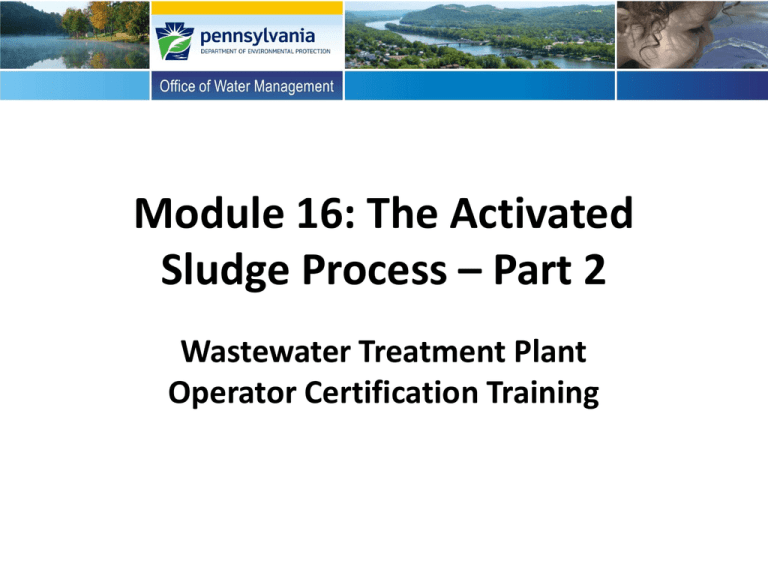
Module 16: The Activated Sludge Process – Part 2 Wastewater Treatment Plant Operator Certification Training Unit 1–Process Control Strategies Learning Objectives • List the key monitoring points within the activated sludge process and explain what to look for at those points. • List five key process control parameters and for each parameter, explain what it is, why it is used and how it is calculated. • List the daily process control tasks that need to be accomplished and explain how to perform them. 2 Key Monitoring Points • Plant influent – check for an increase in flow • In general, activated sludge treatment plants are designed to handle peak flow rates. • If a plant’s hydraulic capacity is exceeded, it may result in reduced detention time in the aeration tank and the loss of sludge from the secondary clarifiers. • Excessive influent flow may be due to stormwater infiltration or unusual industrial discharges. 3 Key Monitoring Points • Plant influent – check for an increase in influent solids • The mixed liquor volatile suspended solids (MLVSS) is the organic or volatile suspended solids in the mixed liquor of an aeration tank. This volatile portion is used as a measure of the bugs present. • If the solids loading exceeds the plant’s design capacity, the MLVSS may need to be adjusted. • Biochemical Oxygen Demand (BOD) is the rate at which organisms use the oxygen while stabilizing decomposable organic matter. 4 Key Monitoring Points • Plant influent – check for an increase in influent solids • If the influent solids increase results in increased BOD loading, then you may need to increase the MLVSS in the aeration tank by reducing the sludge wasting rate. • A shock load may result in a decrease in the MLVSS-to-MLSS ratio. The typical optimum MLVSSto-MLSS ratio in activated sludge plants is between 0.7 and 0.8. 5 Key Monitoring Points • Plant influent – monitor treatment plant capacity • Flow, BOD, TSS, ammonia, total Kjeldahl nitrogen (TKN) are the parameters typically used to characterize influent loadings. • Process upsets and permit violations may result when the plant is overloaded. Monitor the influent loadings to avert overloaded conditions. 6 Key Monitoring Points • Primary clarifier – BOD/COD • Well designed and operated primary clarifiers should remove 20 to 40 percent of BOD. – TSS • Well designed and operated primary clarifiers should remove 50 to 70 percent of TSS. – Nutrients • General rule of thumb for the ratio of BOD-to-nitrogento phosphorus in the primary effluent is 100:5:1. 7 Key Monitoring Points • Primary clarifier – If the influent particle sizes are small and colloidal (non-settleable suspended solids), addition of flocculants may be needed to improve BOD and TSS removal efficiencies. – Malfunctioning or improperly operated sludge removal equipment may be responsible for poor clarifier performance. 8 Key Monitoring Points • Aeration tank – Monitoring of the following process control parameters is required to optimize the treatment process: • MLSS/MLVSS • residual DO • pH and total alkalinity • Specific oxygen uptake rate (SOUR) 9 Key Monitoring Points • Aeration tank process control parameters – MLSS/MLVSS • MLSS concentration is a measure of the total concentration of solids in the aeration tank. • Typical MLSS concentrations for conventional plants range from 2,000 to 4,000 mg/L. • MLVSS is an indirect measure of the concentration of microorganisms in the aeration tank and should be between 70 and 80 percent of the MLSS. 10 Key Monitoring Points • Aeration tank process control parameters – Residual Dissolved Oxygen (DO) • Microorganisms in the aeration tank require oxygen to oxidize organic waste. • A DO concentration between 2 to 4 mg/L is usually adequate to achieve a good quality effluent. 11 Key Monitoring Points • Aeration tank process control parameters – pH and Total Alkalinity • In general, the optimum pH level for bacterial growth ranges between 6.5 and 7.5. • Low pH values may inhibit the growth of nitrifying organisms and encourage the growth of filamentous organisms. • The optimum pH range for nitrification is 7.8 to 8.2 12 Key Monitoring Points • Aeration tank process control parameters – Specific Oxygen Uptake Rate (SOUR) • SOUR is a measure of the quantity of oxygen consumed by the bugs and is a relative measure of the rate of biological activity. • As microorganisms become more active, the SOUR increases and vice versa. • SOUR is measured in mg O2/g MLVSS-hr. 13 Key Monitoring Points • Aeration tank process control parameters – Specific Oxygen Uptake Rate (SOUR) continued • The SOUR and final effluent COD can be correlated. Therefore, changes in the SOUR can be used to predict final effluent quality. • If SOUR increases it is indicative of an increase in the MLSS respiration rate and may require additional oxygen to stabilize. 14 Key Monitoring Points • Aeration tank – Color • If there is white, crisp foam present on the surface of the aeration tank, decrease the sludge wasting rate as needed. • A thick, dark brown or gray, greasy foam indicates the presence of a slow-growing filamentous organism, usually of the Nocardia genus. 15 Key Monitoring Points • Aeration tank – Microscopic examination of the biomass (mixed liquor) • Recording observations, such as size and nature of floc particles and the type and number of organisms, will enable you to make qualitative assessments. 16 Key Monitoring Points • Secondary clarifier – sludge blanket • Monitor the thickness of the sludge blanket to avoid wash-out of solids from the clarifier. • The sludge blanket level must be determined by experience and must provide adequate settling depth and sludge storage. • Typically, secondary clarifiers allow for 2-3 ft of depth for thickening, 3 ft for a buffer zone between the thickened sludge and the clarification zone, and 8 ft for clarification. 17 Manual Sludge Judge 18 Ex. 1 Ultrasonic Automated Sludge Blanket Monitor 19 Ex. 2 Ultrasonic Automated Sludge Blanket Monitor 20 Key Monitoring Points • Secondary clarifier – sludge return rate • Important in controlling and maintaining an adequate MLSS concentration in the aeration tank. • Pumping rates are typically 50 to 100 percent of the wastewater flow rate for large plants and up to 150 percent for small plants. • Inadequate RAS pumping rates can result in a rising sludge blanket. • The return-sludge flow rate should be adjusted to maintain the sludge blanket as low as possible. 21 Key Monitoring Points • Secondary clarifier – floating solids on clarifier surface • Floating solids on the clarifier surface are an indication of a problem called “rising sludge.” • Rising sludge occurs when the DO concentration in the secondary clarifier drops resulting in an anoxic, or oxygen deficient, condition. • Under anoxic conditions, nitrifying bacteria convert nitrate to nitrogen gas. The nitrogen gas bubbles adhere to floc particles, causing them to rise to the surface. 22 Key Monitoring Points • Internal plant recycles – Supernatant from anaerobic digesters or sludge holding tanks and the clarified water from sludge dewatering process or thickening processes are typically recycled back to the primary clarifiers. – It is important to monitor the solids levels in these recycled streams to avoid the buildup of excessive levels of inert solids in the secondary treatment system. 23 Typical Internal Plant Recycles 24 Key Monitoring Points • Plant effluent – check turbidity • Turbidimeters measure the amount of light scattered by the suspended particles and give a qualitative measure of the TSS concentration. • Turbidimeters may be real-time or bench-top units for testing grab samples. • Turbidity is measured in nephalometric transfer units (NTU). 25 Key Monitoring Points • Plant effluent – NPDES permit requirements may vary from one plant to another. See the typical permit requirements on the following slide. – EPA has established the following minimum national standards for secondary treatment plants. Parameter Units 30-day Average Concentration 7-day Average Concentration BOD5 mg/L 30 45 Suspended Solids (TSS) mg/L 30 45 pH CBOD5 pH units mg/L must be between 6.0 and 9.0 25 40 26 Key Monitoring Points Typical Permit Parameters Parameter Typical Discharge Limitation flow rate varies BODs 30 mg/L monthly avg., 45 mg/L weekly avg. TSS 30 mg/L monthly avg., 45 mg/L weekly avg. pH 6.0 to 9.0 total residual chlorine 0.038 mg/L daily max., 0.08 mg/L weekly avg. fecal coliform 400#/100 mL daily max. total recoverable metals varies hardness (as CaCO3) no limit, just monitor total phosphorus 1 mg/L monthly avg ammonia nitrogen no limit, just monitor acute whole effluent toxicity (WET) Toxic Unit – Acute (TUa) must be <1 chronic WET (must be negative) Relative Toxic Unit – Chronic (rTUc) must be <1 27 Checkpoint • What are the six key monitoring points within the activated sludge process? - plant influent - primary clarifier effluent - aeration tank - secondary clarifier - internal plant recycles - plant effluent 28 Checkpoint • What are the key characteristics you should look for at each of the monitoring points? - plant influent – check for flow increase and influent solids increase - primary clarifier effluent – check BOD/COD, TSS and nutrients - aeration tank – check MLSS/MLVSS, residual DO, pH and total alkalinity, SOUR, color and the biomass - secondary clarifier – check sludge blanket level, sludge return rate and floating solids on clarifier surface - internal plant recycles – check digester or sludge holding tank supernatant and sludge dewatering or thickening process recycle 29 5 Key Process Control Parameters • Mean Cell Resident Time (MCRT) • Food-to-Microorganism (F/M) ratio • Sludge Volume Index (SVI) • Specific Oxygen Uptake Rate (SOUR) • Sludge (Solids)Wasting 30 5 Key Process Control Parameters • Mean Cell Resident Time (MCRT) – Is an average measure of how long the bugs remain in contact with the substrate (food source) and is also known as solids retention time (SRT). – Used to control the mass of MLVSS in the aeration tank. – The desired MCRT is achieved by adjusting the sludge wasting and return rates. – MCRTs ranging from 3 to 15 days are typical for conventional activated sludge plants. – MCRTs less than 3 days will produce a sludge that is young and slow settling and produce a turbid effluent. 31 5 Key Process Control Parameters • Mean Cell Resident Time (MCRT) – MCRT, days = SS in aeration system, lbs SS lost from the aeration system, lbs/day OR – MCRT, days = SS in aeration tank, lbs SS in the effluent, lbs/day + solids wasted, lbs/day 32 5 Key Process Control Parameters • Calculate the MCRT assuming the following: – Aeration Tank Volume is 1,000,000 gal – Wastewater flow to aeration tank is 4.0 mgd – Sludge wasting rate = 0.075 mgd – MLVSS = 2,000 mg/l – Waste sludge VSS = 6,200 mg/l – Final effluent VSS = 10 mg/l 33 5 Key Process Control Parameters • SS in the aeration tank, lbs = 2,000 mg/l x 1.0 mil. gal. x 8.34 = 16680 lbs • SS lost from the aeration system, lbs/day = effluent SS lbs/day + WAS SS lbs/day – Effluent SS lbs/day = 10 mg/l x 4.0 mgd x 8.34 = 333.6 lbs/day – WAS SS lbs/day = 6,200 mg/l x 0.075 mgd x 8.34 = 3878.1 lbs/day Substituting into the MCRT equation: MCRT, days = 16680 lbs = (333.6 + 3878.1) lbs/day 34 3.96 days Checkpoint • Calculate the MCRT assuming the following: – Aeration Tank Volume is 250,000 gal – # of aeration tanks = 4 – Wastewater flow to each aeration tank = 1.25 mgd – Sludge wasting rate = 0.1 mgd – MLVSS = 2,000 mg/l – Waste sludge VSS = 8,000 mg/l – Final effluent VSS is negligible 35 Checkpoint • Step 1: Calculate the total aeration tank volume – Total volume = 250,000gal x 4 = 1 mgal • Step 2: Calculate total wastewater flow – Total flow = 1.25mgd x 4 = 5 mgd • Step 3: Calculate MCRT 1 mgal x 2000 mg/l x 8.34 (0.1 mgd x 8000 mg/l x 8.34) + (5 mgd x 0 mg/l x 8.34) = 2.5days 36 5 Key Process Control Parameters • Food-to-Microorganism (F/M) ratio – is a measure of the mass of food available in the primary effluent per unit mass of MLVSS per unit time and has units of lb BOD or COD/lb MLVSSday. – Food-to-Microorganism (F/M) ratio is calculated as follows: F/M = Influent BOD (or COD) lbs/day MLVSS in aeration, lbs/day 37 5 Key Process Control Parameters • Food-to-Microorganism (F/M) ratio – The MLVSS represents the concentration of organisms in the aeration tank. – COD is often used instead of BOD because test results are available four hours after sample collection instead of five days for BOD test results. – The F/M ratio can be used to control the concentration of MLVSS in the aeration tank. – To maintain a MLVSS concentration, the sludge wasting rate will need to be adjusted. 38 5 Key Process Control Parameters • Calculate the F/M given the following: – Influent flow rate = 10 mgd – Primary effluent COD = 200 mg/l – MLVSS = 1550 mg/l – # of aeration tanks in parallel = 4 – Aeration tank dimensions: – Depth of water = 20 ft – Length = 120 ft – Width = 24 ft 39 5 Key Process Control Parameters • Influent COD lbs/day = (200 mg/l) x (10 mgd) x 8.34 = 16680 lbs/day COD • Volume of aeration tanks = 4 x (20’ x 120’ x 24’) x 7.48 gal/ft3 = 1,723,392 gal or 1.72 mgal • MLVSS, lbs = (1.72 mgal) x (1550mg/l MLVSS) x 8.34 = 22240 lbs MLVSS • F/M = 16680 lbs/day COD = 0.75 22240 lbs MLVSS-day 40 Checkpoint • Calculate the F/M given the following: – Aeration Tank Volume is 500,000 gal – Influent BOD5 = 200 mg/l – Influent flow = 1.0 mgd – MLVSS = 2,000 mg/l 41 Checkpoint • Step 1: Calculate the influent BOD5 – Influent BOD5 = (200 mg/l) x (1.0 mgd) x 8.34 = 1668 lbs/day • Step 2: Calculate the lbs of MLVSS in aeration – MLVSS in aeration = (0.5 mgd) x (2000 mg/l) x 8.34 = 8340 lbs MLVSS-day • Step 3: Calculate F/M ratio F/M = 1668 lbs/day BOD5 = 0.2 8340 lbs MLVSS-day 42 5 Key Process Control Parameters • Sludge Volume Index (SVI) – Is the volume in mL occupied by one gram of MLSS after 30 minutes of settling in a 1,000 mL graduated cylinder and has units of mL/g. – The SVI is a measure of the settleability of the activated sludge in a secondary or final clarifier. – Lower values of the SVI indicate better sludge settleability. – The preferable range for the SVI is 50 to 150 mL/g. 43 5 Key Process Control Parameters • Sludge Volume Index (SVI) – SVI, mL/g = % settleable solids x 10,000 MLSS (mg/L) OR – SVI, mL/g = settled sludge volume/sample volume (mL/L) x 1,000 mg MLSS (mg/L) 1gm 44 Checkpoint • Calculate the SVI for an activated sludge sample given the following: – 30-minute settleable solids volume = 150 mL – MLSS = 3,000 mg/L 45 Checkpoint • SVI, mL/g = % settleable solids x 10,000 MLSS (mg/L) – Step 1: Calculate the % settleable solids % settleable solids = (150/1000) x 100 = 15 mL/g – Step 2: Calculate the SVI SVI = 15 x 10,000 = 50 mL/g 3,000 46 Checkpoint • SVI, mL/g = settled sludge volume/sample volume (mL/L) x 1,000mg MLSS (mg/L) 1gm SVI = 150 mL/1L x 1,000 mg = 50 mL/g 3,000 mg/L 1 gm 47 Checkpoint • Calculate the SVI for an activated sludge sample given the following: – 30-minute settleable solids volume = 200 mL – MLSS = 2,000 mg/L 48 Checkpoint • SVI, mL/g = % settleable solids x 10,000 MLSS (mg/L) – Step 1: Calculate the % settleable solids % settleable solids = (200/1000) x 100 = 20 mL/g – Step 2: Calculate the SVI SVI = 20 x 10,000 = 100 mL/g 2,000 49 5 Key Process Control Parameters • Specific Oxygen Uptake Rate (SOUR) – SOUR is a measure of the quantity of oxygen consumed by microorganisms and is a relative measure of the rate of biological activity. – As microorganisms become more active, the SOUR increases and vice versa. – Changes in the SOUR can be used to predict final effluent quality. 50 5 Key Process Control Parameters • Specific Oxygen Uptake Rate (SOUR) – SOUR is determined by taking a sample of mixed liquor, saturating it with oxygen, and measuring the decrease in oxygen with a DO probe with time. – The results of that test, Oxygen Uptake Rate (OUR), measured in mg O2/L-min, is divided by the MLVSS to yield the SOUR, measured in mg O2/g MLVSS-hr. – Refer to Method 2710 B. “Oxygen-Consumption Rate” in Standard Methods for the Examination of Water and Wastewater for details on SOUR determination. 51 5 Key Process Control Parameters • Sludge (Solids)Wasting – Solids in waste activated sludge (WAS) come from two sources. • The primary source of WAS is from the growth of new bacterial cells in the aeration tank. • The second source is from organic and inorganic solids in the raw wastewater that pass through the primary clarifiers. – Sludge is wasted to maintain the desired mass of microorganisms in the aeration tank. It’s typically wasted when the actual MCRT is higher than the target value. 52 5 Key Process Control Parameters • Sludge (Solids)Wasting – Typical secondary clarifiers thicken the activated sludge to three to four times the concentration in the aeration tank. – WAS (and return activated sludge, RAS) MLSS concentrations may range from 2,000 to 10,000 mg/l (0.2 to 1.0 percent). – Waste sludge on a continuous basis, changing the WAS rate as needed by no more than 10 to 15 percent from one day to the next. 53 5 Key Process Control Parameters 54 5 Key Process Control Parameters • Sludge (Solids)Wasting – Two means of wasting sludge are through the primary clarifier or through a solids thickener. – WAS is typically wasted from the return activated sludge (RAS) line to either the primary clarifier or a solids thickener to reduce the water content prior to anaerobic digestion, as shown in the next slide. 55 Solids Wasting 56 Solids Wasting • Calculating Sludge Wasting Rates (WAS) – WAS rates may be calculated based on several different parameters such as: • F/M ratio • Target MCRT 57 Checkpoint • Calculate the WAS in mgd given the following: – MCRT = 3.96 days – Aeration Tank Volume is 1,000,000 gal – Wastewater flow to aeration tank is 4.0 mgd – MLVSS = 2,000 mg/l – Waste sludge VSS = 6,200 mg/l – Final effluent VSS = 10 mg/l 58 Checkpoint • Calculate the WAS in mgd given the following: – Volume of aeration tank = 1.7 Mgal – MLVSS = 1,600 mg/L – plant effluent flow = 10 mgd – VSS in effluent = 10 mg/L – MCRT = 5 days – VSS in WAS = 8,000 mg/L 59 Daily Process Control Tasks • Record Keeping – Raw data such as meter readings and visual observations are typically recorded in some type of log book while lab data are typically kept in a separate file. – The raw data recorded in the log book and the lab files can be used to create summary data sheets. – Maintaining consistent records will help you develop an understanding of the activated sludge process and determine the optimal ranges for process parameters, as well as, enable you to identify potential plant upset conditions before they impact the plant’s effluent quality. 60 Example 1 of Monthly Data Sheet 61 Example 2 of Monthly Data Sheet 62 Example 1 of Process Parameter Plot 63 Example 2 of Process Parameter Plot 64 Daily Process Control Tasks • Record Keeping – There are several process parameters that should be monitored daily and recorded. They include: • TSS and VSS • BOD, COD or TOC • DO • settleable solids/SVI • temperature • pH • clarity • chlorine demand • coliform group bacteria 65 Typical Influent Wastewater Temperatures 66 Daily Process Control Tasks • Record Keeping – In addition to process control parameters, the following meter readings must be recorded to assist with monitoring plant performance. • Daily influent flow • Return sludge pumping rate • Waste sludge pumping rate • Air flow to diffused air system or hours operated at specific motor speeds for mechanical aeration. 67 Daily Process Control Tasks • Daily Process Control Tasks – In addition to record keeping the following tasks should be performed: • Observation of plant flow, color, odor, scum, turbulence, clarity, etc...for any irregularities. • Examine mechanical equipment and motors for excessive vibrations, noises and temperature. • Review the log book • Review the lab data 68 Key Points and Exercise • Turn to page 1-35 to summarize the unit key points. • Turn to page 1-36 for the exercise 69 Unit 2–Typical Operational Problems Learning Objectives • List six common process operational problems. • List and explain possible plant changes that may result in process operational problems. • Define sludge bulking, explain what causes it and identify possible solutions. • Define septic sludge, explain what causes it and explain possible solutions. 70 Unit 2–Typical Operational Problems Learning Objectives • List five classifications of toxic substances and explain their effects on biological treatment systems. • List and explain institutional, design and process controls that can be used to control toxic substances. • Define rising sludge, explain what causes it and identify possible solutions. 71 Unit 2–Typical Operational Problems Learning Objectives • Explain what causes foaming/frothing and possible solutions. • Explain the significance of the Process Troubleshooting Guide. • List and explain seven common equipment operational problems. • Describe the maintenance required for the various aeration equipment. 72 Typical Operational Problems • Plant Changes – High Digester Supernatant Solids – Plant Influent Flow and Waste Characteristic Changes (BOD/COD, TSS) – Temperature Changes – Sampling Program Changes 73 Typical Operational Problems • Sludge Bulking – describes a condition in which activated sludge has poor settling characteristics and poor compatibility. – Causes • The presence of filamentous organisms is the predominant cause of sludge bulking. • The presence of excess water, or bound water, in the bacteria cells reduces the sludge density. • Low pH, low DO and low nutrient concentrations have been linked to sludge bulking, but high F/M ratios (and low MCRTs) are the primary cause for repeated bulking. 74 Typical Operational Problems • Sludge Bulking – Solutions • Increase the MCRT • Increase the DO • Increase hydraulic detention time in the aeration basin • Chlorinate the return sludge • Add flocculant • Control sulfide ions entering the aeration tanks 75 Typical Operational Problems • Septic Sludge – is any sludge that has become anaerobic and is characterized by a foul odor. – Causes • Sludge becomes septic when it is allowed to sit stagnant long enough to deplete residual DO. • Sludge may turn septic if allowed to accumulate in pockets or “dead spots” too long. • Inadequate mixing in aeration tank • Inadequate return sludge rates in secondary clarifiers 76 Typical Operational Problems • Septic Sludge – Solutions • Completely mix the contents of the aeration tank. • Maintain a flow velocity of at least 1.5 ft/sec to prevent sludge deposition. • Increase the return sludge rate to reduce the detention time. • Make sure the clarifier collection mechanism is on so that solids are removed from the draw-off hopper. • Make sure the sludge draw-off lines are not plugged. • Make sure the return sludge pumps and valves are operating properly. 77 Typical Operational Problems • Rising Sludge – is the term used to describe sludge that slowly rises to the surface of secondary clarifiers. Rising sludge is differentiated from sludge bulking by the presence of gas bubbles on the surface of the clarifier. – Causes • Rising sludge is caused by the process of denitrification in the secondary clarifiers. 78 Typical Operational Problems • Rising Sludge – Solutions • Increase the return sludge rate to decrease the detention time of the sludge in the clarifier. • Decrease the flow rate of activated sludge to the problematic clarifier if the return sludge rate can not be increased. • Increase the speed of the sludge collecting mechanism in the clarifier. • Decrease the MCRT by increasing the wasting rate. 79 Typical Operational Problems • Foaming/Frothing – is the condition describing a buildup of foam or froth on the surface of the aeration tank. – Causes • a low MLSS • nutrient deficiencies, solids recycled from dewatering processes, the presence of surfactants (detergents) in the plant’s influent, over aeration and polymer overdosing. • filamentous bacteria Nocardia. Nocardia foam is thick, dark brown foam that can be caused by a low F/M ratio, high MLSS (high MCRT) due to insufficient wasting and reaerating activated sludge. 80 Typical Operational Problems • Foaming/Frothing – Solutions are dependent on cause • Increase the MLSS concentration • Reduce the air supply during periods of low flow • Return digester supernatant slowly to the aeration tank during periods of low flow • Reduce the MCRT • Add a biological foam control agent • Chlorinate the return sludge • Spray chlorine solution or sprinkle calcium hypochlorite directly on surface of foam • Reduce the pH 81 Typical Operational Problems • Toxic Substances – The EPA has developed a list of approximately 150 toxic substances, or “priority pollutants”. – Categorical discharge standards are used to regulate the discharge of priority pollutants to publicly owned treatment works (POTWs) by commercial and industrial sources. – WWTPs discharging to surface waters are required to monitor their effluents for and comply with certain priority pollutant discharge limitations. – The toxicity of wastewater treatment plant effluents is typically measured using the whole effluent toxicity (WET) test. 82 Typical Operational Problems • Toxic Substances – Priority pollutants fall into the following classifications: • heavy metals • inorganic compounds • organic compounds • halogenated compounds • pesticides, herbicides and insecticides 83 Typical Operational Problems • Toxic Substances – Effects on Biological Treatment Systems • In general, toxic organic compounds may be removed, transformed, generated or passed through the system unchanged. Typically present at concentrations that are non-toxic. • Inorganic compounds, such as copper, lead, silver, chromium, arsenic, and boron cations (positively charged ions) can be toxic to microorganisms. • Potassium, ammonium and elevated concentrations of sodium can be toxic to bacteria in sludge digesters. 84 Typical Operational Problems • Toxic Substances – Controls: • Institutional Controls –Prohibited Discharge Standards –Categorical Standards • Design Controls • Process Controls 85 Checkpoint • Turn to page 2-12 for the exercise 86 Processing Troubleshooting • Process Troubleshooting Guidance – One of the most important principles in process troubleshooting is to make only one process change at a time and to give the system adequate time to respond to the change before making another change. – You will typically need to allow one week for the plant to stabilize after making a process change. 87 Processing Troubleshooting Guide 88 Checkpoint • Turn to page 2-16 for the exercise 89 Equipment Problems and Maintenance 90 Equipment Problems and Maintenance • Surface Aerator Maintenance – Follow the manufacturer’s O & M manuals. – General guidelines: • Motors • Gear reducers • Coupling and impeller 91 Equipment Problems and Maintenance • Air Filters – Operational problems and maintenance • The cleanliness of air filters is typically measured by the pressure difference between the inlet and outlet with a manometer. • The pressure difference will increase as the filters are loaded with particulate. • Excessive pressure drops across the air filters will result in reduced blower performance. • Air filters should be removed, cleaned and reinstalled according to the manufacturer’s operation and maintenance manual. 92 Equipment Problems and Maintenance • Blowers – Operational problems may include: • unusual noises or vibration • air flow problems • motor problems • oil temperature problems 93 Equipment Problems and Maintenance • Blower Maintenance – Generally, all new oil-lubricated equipment requires a “break in” period of about 400 hours before changing the oil. – Change the oil after every 1,400 hours of operation. – Check the drained oil after “break in” period for metal particulates. – Lubricate the grease-lubricated bearings after every 500 hours of operation. – See the aerator section for blower motor maintenance. – Check all valves 94 Equipment Problems and Maintenance 95 Equipment Problems and Maintenance • Air Distribution System Maintenance – Inspect the following at least every six months: • • • • Loose pipe support clamps. Shifting of pipes out of original alignment. Loose nuts and bolts on flanges and fittings. Seized valves (exercise valves with the blower off at least once a month to prevent seizing). • Corrosion damage. • Prevent metal surfaces from corroding by maintaining paint coatings. 96 Equipment Problems and Maintenance 97 Equipment Problems and Maintenance • Air Headers/Diffusers Maintenance – Monthly: • Exercise all regulating/isolation valves to prevent seizing. • Apply grease to the upper pivot swing joint O-ring cavity (swing header). • Check for loose fittings, nuts and bolts. • Increase air flow to the diffusers to 2-3 times the normal flow to blow out biological growths. • Loose nuts and bolts on flanges and fittings. 98 Equipment Problems and Maintenance • Air Headers/Diffusers Maintenance – Yearly: • Raise the headers, clean and check for loose fittings, nuts and bolts. • Apply grease to the pivot joint O-ring cavity (swing header). • Check for corrosion and paint, as necessary, with epoxy coating. • Raise the header and inspect diffusers for damage. Clean and replace diffusers as needed. 99 Equipment Problems and Maintenance • Motors and Gear Reducers – Operational problems and maintenance • See the surface aerator section for information on motor and gear reducer operational problems on page 2-18 of your workbook. 100 Key Points and Exercise • Turn to page 2-28 to summarize the unit key points. • Turn to page 2-29 for the exercise 101 Unit 3–Microbiology of the Activated Sludge Process Learning Objectives • Explain why microbiology is important in the activated sludge process. • List and identify four typical microorganisms found in activated sludge. • List the equipment required during sample collection. 102 Unit 3–Microbiology of the Activated Sludge Process Learning Objectives • Identify four sampling locations for various treatment plant processes. • Explain two methods of sample preparation. • Identify the components of a microscope typically used at Wastewater Treatment Plants. 103 Unit 3–Microbiology of the Activated Sludge Process Learning Objectives • Explain three common observations that are recorded. • List and explain three means of interpreting results of microscopic observations. • Explain how to decide when to make a process change. 104 Unit 3–Microbiology of the Activated Sludge Process Learning Objectives • List possible process changes that can be made and explain what the purpose of each process change is. • Explain how frequently processes should be monitored during good operations, poor operations and following a process change. 105 Microbiology of the Activated Sludge Process • Activated Sludge – The activated sludge process is a living process that requires knowledge of the microorganisms involved. – You should know which microorganisms are desirable and undesirable and how these microorganisms respond to the environment in the aeration tanks. 106 Microbiology of the Activated Sludge Process • Microbiology as a Tool – Microscopy may be used to control the process. – The numbers and types of microorganisms in a sample can be helpful in determining what is happening and deciding which process change to make. – It can be used to forecast potential plant upsets. – Incorporating microscopic observations into your routine process control strategy will enable you to “see” the beginning stages of deteriorating conditions before any significant impact to the final effluent quality. 107 Microbiology of the Activated Sludge Process • Bacteria – Bacteria are single-celled organisms and are the most predominant organisms in activated sludge. – They are categorized by their shape to include: • Coccus – round or spherical shape • Bacillus – cylindrical or rod shape • Spirillum – spiral shape 108 Typical Growth Cycle for Bacteria 109 MICROORGANISMS IN ACTIVATED SLUDGE • Bacteria growth occurs in four stages: – The lag phase - cells become acclimated to the waste and begin to divide. – The log-growth phase - cells divide at their generation rate because there is plenty of food available. – The stationary phase - the growth rate decreases due to the depletion of the food supply. – The death phase (also called the “endogenous” phase) cells begin to feed on themselves in the absence of another food supply. 110 MICROORGANISMS IN ACTIVATED SLUDGE • Filaments – Filaments are formed by filamentous bacteria, which attach themselves to each other, forming multi-cellular chains. – Filaments can be classified as “long” and “short.” • Long filaments are the “backbone” that holds bacterial flocs together, giving them good settling characteristics. • Sludge bulking results when filaments begin to predominate and grow out of control. • The most common short filament is called Nocardia. Nocardia form short, web-like branches and can cause foaming and/or frothing in the aeration tanks and excessive brown floating scum in secondary clarifiers. 111 Filamentous Bacteria in Sludge Bulking 112 MICROORGANISMS IN ACTIVATED SLUDGE • Protozoa – Protozoa are single celled organisms ranging in size from 10 microns to over 300 microns. – They are easily visible under the microscope at 100X magnification. – The presence or absence of protozoa is an indicator of the amount of bacteria in the sludge and the degree of treatment. – There are five types of protozoa - amoeba, mastigophora, free-swimming ciliate, stalked ciliate, and suctoria. 113 Protozoa 114 MICROORGANISMS IN ACTIVATED SLUDGE • Rotifers – are multicellular animals with rotating cilia on the head and a forked tail. – are an indication of an old activated sludge with a high MCRT and are usually associated with a turbid effluent. • Worms – are strict aerobes and can metabolize solid organic matter not easily metabolized by other microorganisms. – are usually found in sludge from extended aeration plants. 115 SAMPLE COLLECTION AND PREPARATION • Sample Collection – You will need a dipper pole with a bottle holder or other appropriate collection equipment. – Use a 100 to 300 mL plastic bottle. – Collect your sample from the same spot in the aeration tank at the same time each day. – Conduct the microscopic observation within 15 minutes. 116 Dipper Pole and Bottle Holder 117 Sampling Locations 118 SAMPLE COLLECTION AND PREPARATION • Sample Preparation – There are two methods of sample preparation: • a wet mount slide is used to observe live organisms. • a stained dry slide is used to observe filamentous bacteria. 119 Compound Microscope 120 Microorganism Counts on a Slide 121 Worksheet for Microorganism Counting 122 Technique for Counting Filaments 123 Indicators of Stable and Unstable Treatment Processes 124 SAMPLE COLLECTION AND PREPARATION • Response to Results – Microscopy vs. Process Data – Changes in Microorganism Populations – Deciding When to Make a Process Change – Which Process Changes to Make – How Much Change to Make 125 SAMPLE COLLECTION AND PREPARATION • Monitoring Processes – The frequency of monitoring should be based on plant performance. • Good operation – two to three times per week or to suit your comfort level • Poor operation – Return to daily or twice-daily microscopic observations • Following a process change – Return to daily or twice-daily microscopic observations after a process change until it’s been determined the correct change was made. 126 Key Points and Exercise • Turn to page 3-20 to summarize the unit key points. • Turn to page 3-21 for the exercise 127
